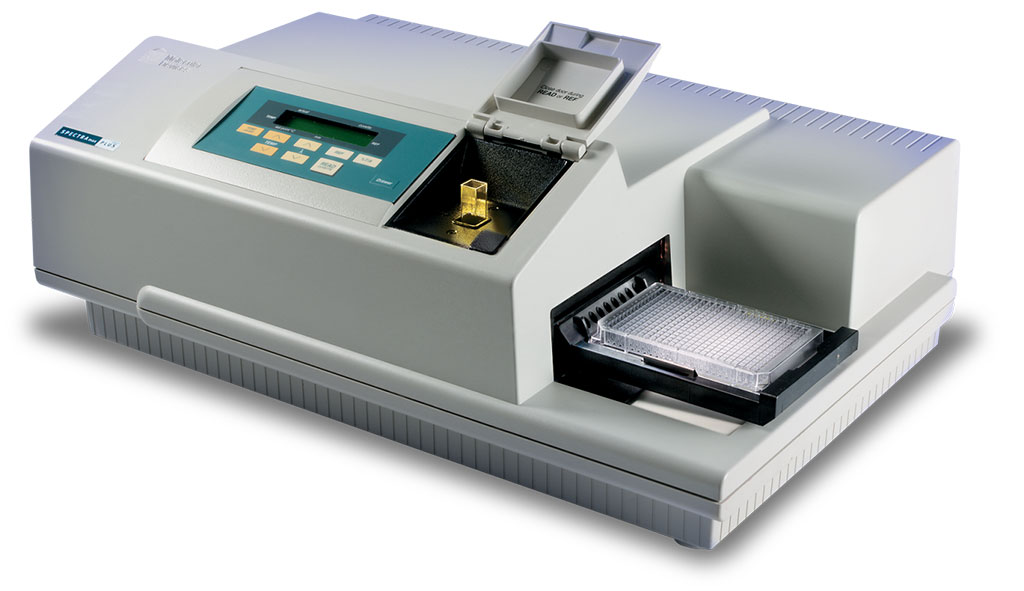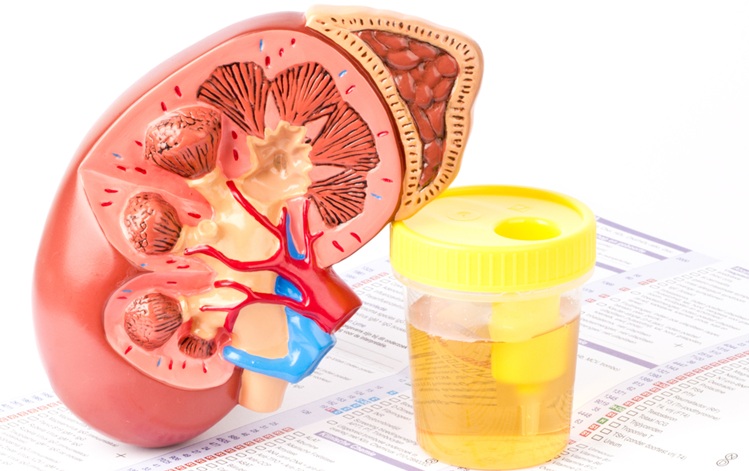Urinary VEGFA and Renal Pathology Evaluated for IgA Nephropathy Patients
|
By LabMedica International staff writers Posted on 25 Sep 2021 |

The SpectraMax Plus 384 Microplate Reader can run both standard spectrophotometer and microplate reader applications on the same instrument (Photo courtesy of Molecular Devices)
Immunoglobulin A (IgA) nephropathy (IgAN) is the most common primary glomerulonephritis and is the leading cause of end-stage renal disease (ESRD) in China. Renal biopsy remains the golden standard for diagnosing and monitoring IgA nephropathy (IgAN).
Vascular endothelial growth factor-A (VEGFA) is an essential angiogenic cytokine and found to be crucial for the survival, differentiation and structure maintaining of these glomerular cells. VEGFA is therefore, pivotal for maintaining the glomerular filtration barrier function. The relationship of urinary and renal VEGFA in IgAN patients are still not clear.
Nephrologists at the Sun Yat-sen University (Guangzhou, China) recruited a total of 85 IgAN patients and 71 healthy controls without microscopic hematuria, proteinuria, hepatic disease and with normal serum creatinine. Samples of IgAN patients were obtained at the day of renal biopsy. Serum and morning urine collected from each subject were transferred to a separate vial after centrifuge and stored at −80 ℃ until assayed.
Serum levels of VEGFA were measured by ELH-VEGF-1 ELISA (RayBiotech, Peachtree Corners, GA, USA), and urine VEGFA levels were measured by ELISA from R&D Systems (Minneapolis, MN, USA). Absorbance was measured at 450 nm using the SpectraMax Plus 384 Microplate reader (Molecular Devices, San Jose, CA, USA). Renal biopsies of 27 IgAN patients were randomly selected from enrolled 85 IgAN patients and used for VEGFA testing by immunohistochemistry analysis. The expression levels of VEGFA and Glyceraldehyde 3-phosphate dehydrogenase (GAPDH) were quantified by real-time PCR using Taqman with a fluorescence detection monitor 7900 Real-time PCR system (Applied Biosystems, Waltham, MA, USA).
The investigators reported that compared with healthy controls, urinary VEGFA level was elevated in IgAN patients (76.19 ± 63.67 pg/mg Cr versus 146.67 ± 232.71 pg/mg Cr), and not correlated with serum VEGFA level. Baseline urinary VEGFA was significantly associated with gender and tubular atrophy/interstitial fibrosis by stepwise multivariate regression analysis. Urinary VEGFA was higher in male patients accompanied with higher serum creatinine, larger proportion of hypertension and recurrent hematuria than in female patients. In the kidney of IgAN patients, VEGFA were robustly expressed in the parietal epithelial cells, podocytes, mesangial cells and tubular epithelial cells. After a follow-up duration of 38.53 ± 27.14 months, IgAN patients with higher urinary VEGFA level were found to have a poorer renal outcome of renal replacement therapy.
The authors concluded that increased urinary VEGFA might reflect certain renal pathology and, although not fully specific, still could be served as a valuable noninvasive indicator in predicting renal progression of IgAN. The study was published on September 8, 2021 in the Journal of Clinical Laboratory Analysis.
Related Links:
Sun Yat-sen University
RayBiotech
R&D Systems
Molecular Devices
Applied Biosystems
Vascular endothelial growth factor-A (VEGFA) is an essential angiogenic cytokine and found to be crucial for the survival, differentiation and structure maintaining of these glomerular cells. VEGFA is therefore, pivotal for maintaining the glomerular filtration barrier function. The relationship of urinary and renal VEGFA in IgAN patients are still not clear.
Nephrologists at the Sun Yat-sen University (Guangzhou, China) recruited a total of 85 IgAN patients and 71 healthy controls without microscopic hematuria, proteinuria, hepatic disease and with normal serum creatinine. Samples of IgAN patients were obtained at the day of renal biopsy. Serum and morning urine collected from each subject were transferred to a separate vial after centrifuge and stored at −80 ℃ until assayed.
Serum levels of VEGFA were measured by ELH-VEGF-1 ELISA (RayBiotech, Peachtree Corners, GA, USA), and urine VEGFA levels were measured by ELISA from R&D Systems (Minneapolis, MN, USA). Absorbance was measured at 450 nm using the SpectraMax Plus 384 Microplate reader (Molecular Devices, San Jose, CA, USA). Renal biopsies of 27 IgAN patients were randomly selected from enrolled 85 IgAN patients and used for VEGFA testing by immunohistochemistry analysis. The expression levels of VEGFA and Glyceraldehyde 3-phosphate dehydrogenase (GAPDH) were quantified by real-time PCR using Taqman with a fluorescence detection monitor 7900 Real-time PCR system (Applied Biosystems, Waltham, MA, USA).
The investigators reported that compared with healthy controls, urinary VEGFA level was elevated in IgAN patients (76.19 ± 63.67 pg/mg Cr versus 146.67 ± 232.71 pg/mg Cr), and not correlated with serum VEGFA level. Baseline urinary VEGFA was significantly associated with gender and tubular atrophy/interstitial fibrosis by stepwise multivariate regression analysis. Urinary VEGFA was higher in male patients accompanied with higher serum creatinine, larger proportion of hypertension and recurrent hematuria than in female patients. In the kidney of IgAN patients, VEGFA were robustly expressed in the parietal epithelial cells, podocytes, mesangial cells and tubular epithelial cells. After a follow-up duration of 38.53 ± 27.14 months, IgAN patients with higher urinary VEGFA level were found to have a poorer renal outcome of renal replacement therapy.
The authors concluded that increased urinary VEGFA might reflect certain renal pathology and, although not fully specific, still could be served as a valuable noninvasive indicator in predicting renal progression of IgAN. The study was published on September 8, 2021 in the Journal of Clinical Laboratory Analysis.
Related Links:
Sun Yat-sen University
RayBiotech
R&D Systems
Molecular Devices
Applied Biosystems
Latest Immunology News
- Blood-Based Liquid Biopsy Model Analyzes Immunotherapy Effectiveness
- Signature Genes Predict T-Cell Expansion in Cancer Immunotherapy
- Molecular Microscope Diagnostic System Assesses Lung Transplant Rejection
- Blood Test Tracks Treatment Resistance in High-Grade Serous Ovarian Cancer
- Luminescent Probe Measures Immune Cell Activity in Real Time
- Blood-Based Immune Cell Signatures Could Guide Treatment Decisions for Critically Ill Patients
- Novel Tool Predicts Most Effective Multiple Sclerosis Medication for Patients
- Companion Diagnostic Test for CRC Patients Identifies Eligible Treatment Population
- Novel Tool Uses Deep Learning for Precision Cancer Therapy
- Companion Diagnostic Test Identifies HER2-Ultralow Breast Cancer and Biliary Tract Cancer Patients
- Novel Multiplex Assay Supports Diagnosis of Autoimmune Vasculitis
- Blood Test Predicts Immunotherapy Efficacy in Triple-Negative Breast Cancer
- Simple Genetic Testing Could Predict Treatment Success in Multiple Sclerosis Patients
- Novel Gene Signature Predicts Immunotherapy Response in Advanced Kidney Cancers
- New Technology Deciphers Immune Cell Communication to Predict Immunotherapy Response
- AI Model Accurately Predicts MSI Tumor and Immune Checkpoint Inhibitor Responsiveness
Channels
Clinical Chemistry
view channel
VOCs Show Promise for Early Multi-Cancer Detection
Early cancer detection is critical to improving survival rates, but most current screening methods focus on individual cancer types and often involve invasive procedures. This makes it difficult to identify... Read more
Portable Raman Spectroscopy Offers Cost-Effective Kidney Disease Diagnosis at POC
Kidney disease is typically diagnosed through blood or urine tests, often when patients present with symptoms such as blood in urine, shortness of breath, or weight loss. While these tests are common,... Read moreMolecular Diagnostics
view channel
Urine Test Detects Early Stage Pancreatic Cancer
Pancreatic cancer remains among the hardest cancers to detect early. In the UK, around 10,000 people are diagnosed each year, but only 5% survive beyond five years. Late diagnosis is a major factor—more... Read more
Genomic Test Could Reduce Lymph Node Biopsy Surgery in Melanoma Patients
Accurately determining whether melanoma has spread to the lymph nodes is crucial for guiding treatment decisions, yet the standard procedure—sentinel lymph node biopsy—remains invasive, costly, and unnecessary... Read moreHematology
view channel
ADLM’s New Coagulation Testing Guidance to Improve Care for Patients on Blood Thinners
Direct oral anticoagulants (DOACs) are one of the most common types of blood thinners. Patients take them to prevent a host of complications that could arise from blood clotting, including stroke, deep... Read more
Viscoelastic Testing Could Improve Treatment of Maternal Hemorrhage
Postpartum hemorrhage, severe bleeding after childbirth, remains one of the leading causes of maternal mortality worldwide, yet many of these deaths are preventable. Standard care can be hindered by delays... Read more
Pioneering Model Measures Radiation Exposure in Blood for Precise Cancer Treatments
Scientists have long focused on protecting organs near tumors during radiotherapy, but blood — a vital, circulating tissue — has largely been excluded from dose calculations. Each blood cell passing through... Read moreMicrobiology
view channel
Fast Noninvasive Bedside Test Uses Sugar Fingerprint to Detect Fungal Infections
Candida bloodstream infections are a growing global health threat, causing an estimated 6 million cases and 3.8 million deaths annually. Hospitals are particularly vulnerable, as weakened patients after... Read more
Rapid Sepsis Diagnostic Device to Enable Personalized Critical Care for ICU Patients
Sepsis is a life-threatening condition that occurs when the body’s response to infection spirals out of control, damaging organs and leading to critical illness. Patients often arrive at intensive care... Read morePathology
view channel
New Molecular Analysis Tool to Improve Disease Diagnosis
Accurately distinguishing between similar biomolecules such as proteins is vital for biomedical research and diagnostics, yet existing analytical tools often fail to detect subtle structural or compositional... Read more
Tears Offer Noninvasive Alternative for Diagnosing Neurodegenerative Diseases
Diagnosing and monitoring eye and neurodegenerative diseases often requires invasive procedures to access ocular fluids. Ocular fluids like aqueous humor and vitreous humor contain valuable molecular information... Read moreTechnology
view channel
Cell-Sorting Device Uses Electromagnetic Levitation to Precisely Direct Cell Movement
Sorting different cell types—such as cancerous versus healthy or live versus dead cells—is a critical task in biology and medicine. However, conventional methods often require labeling, chemical exposure,... Read more
Embedded GPU Platform Enables Rapid Blood Profiling for POC Diagnostics
Blood tests remain a cornerstone of medical diagnostics, but traditional imaging and analysis methods can be slow, costly, and reliant on dyes or contrast agents. Now, scientists have developed a real-time,... Read moreIndustry
view channel
Qiagen Acquires Single-Cell Omics Firm Parse Biosciences
QIAGEN (Venlo, Netherlands) has entered into a definitive agreement to fully acquire Parse Biosciences (Seattle, WA, USA), a provider of scalable, instrument-free solutions for single-cell research.... Read more
Puritan Medical Products Showcasing Innovation at AMP2025 in Boston
Puritan Medical Products (Guilford, ME, USA), the world’s most trusted manufacturer of swabs and specimen collection devices, is set to exhibit at AMP2025 in Boston, Massachusetts, from November 11–15.... Read more
Advanced Instruments Merged Under Nova Biomedical Name
Advanced Instruments (Norwood, MA, USA) and Nova Biomedical (Waltham, MA, USA) are now officially doing business under a single, unified brand. This transformation is expected to deliver greater value... Read more





















